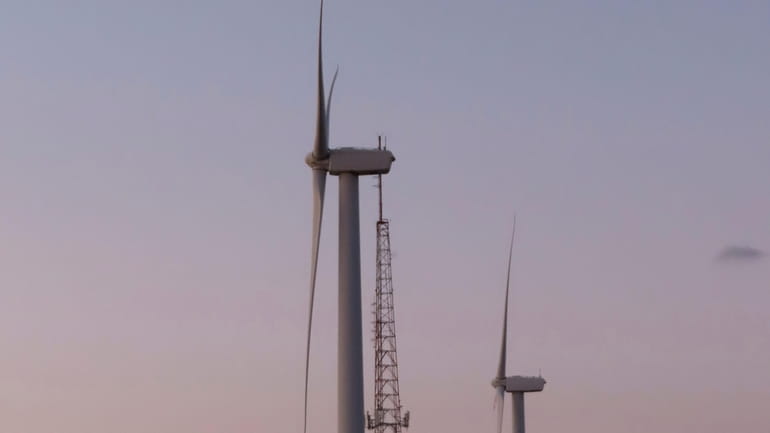State backs $3.3 billion cable plan to carry offshore wind power from Long Island to upstate

A $3.26 billion plan to run high-voltage cables across Long Island to carry wind-generated electricity upstate has won approval by the New York Independent System Operator, which manages state energy markets. Credit: AP / Wayne Parry
Parts of western and central Long Island are slated to become the backbone of a sprawling new network of high-voltage cables for offshore wind energy in a $3.26 billion project that officials said also would relieve a power bottleneck between the island and the rest of New York State.
The project, announced Tuesday by the New York Independent System Operator, promises three new interconnection lines between Long Island and the Bronx and Westchester County using seven new high-voltage cables. The decision to select the project, called Propel NY Energy, was made Tuesday by the board of the NYISO, which manages the state's energy grids.
The project would install a series of new underground lines that would go from Melville, Syosset and Island Park to East Garden City and Glenwood Landing, and then under Long Island Sound to the Bronx and Westchester. All but one of the seven cables will have 345,000-volt capacity, and all will be underground before snaking under the Sound.
These are the proposed routes, which are subject to the regulatory process. Credit: Propel NY Energy
In a statement, the NYISO said the project "will ultimately benefit energy consumers by providing transmission capability to deliver at least 3,000 megawatts from offshore wind projects — advancing the state closer to its goal of 9,000 MW of offshore wind energy by 2035."
WHAT TO KNOW
- Parts of western and central Long Island are slated to become the "backbone" of a new network of high-voltage cables for offshore wind energy in a $3.26 billion project announced Tuesday.
- The project promises three new interconnection lines between Long Island and the Bronx and Westchester County using seven new high-voltage cables.
- New underground cables would go from Melville, Syosset and Island Park to East Garden City and Glenwood Landing, and then under Long Island Sound to the Bronx and Westchester.
'Critical step forward' in reaching climate goals
Selection of the project is a "a critical step forward as the state works to meet its ambitious climate mandates,” Rich Dewey, president and chief executive of the NYISO, said in a statement.
The project is a joint venture of New York Transco and the New York Power Authority and is expected to take several years of planning, permitting and stakeholder meetings before construction can begin in 2026. The cables are expected to be in service by 2030, just after several large offshore wind projects are expected to begin producing energy for the region.
Developers say they plan to use existing rights of way and coordinate the projects to minimize local impact.
The economic benefit of the project is expected to reach $1 billion, Transco and NYPA said.
NYPA's acting president and chief executive, Justin Driscoll, called the selection of the project a "nod to the creative, collaborative teams at the Power Authority and New York Transco that developed this well thought out project that will harden Southeastern New York’s electric grid and help deliver clean energy from offshore wind to New Yorkers."
Propel NY was one of 19 proposals initially offered for the 2021 NYISO solicitation, from four different developers.
Officials said Propel NY was chosen because of its ability to not only export wind power off Long Island but to also “work in the reverse direction and import clean energy from upstate to Long Island.”
New 'backbone' across LI
The new 345,000-volt power lines would create a “new backbone across Long Island,” while improving power transfers between the Island and upstate to provide energy when the wind’s not blowing, said Paul Haering, vice president of capital investment at New York Transco.
Much will hinge on the companies' ability to convince local municipalities and communities of the benefit of the project.
NYPA and New York Transco are expected to need to engage in considerable community outreach in areas where the cables will be laid underground. Pre-permitting work is expected to start later this year.
The state and LIPA are planning for offshore wind power to compose the bulk of electric energy sources as they retire antiquated fossil fuel-fired power plants.
The state already has awarded more than 4,000 megawatts of offshore wind power primarily to European energy companies, most with vast holdings in oil and gas development worldwide. The state is expected to award a new round of offshore projects this summer or fall.
Project costs to be shared statewide
All New Yorkers will help pay the Propel NY Energy project’s $3.26 billion price tag, after the state Public Service Commission last year ruled for LIPA, which requested cost allocation to be based on a utility’s share of energy usage statewide.
For Nassau and Suffolk counties, the share is around 13%, but officials said the region could see cost benefits by alleviating the transmission bottleneck and making cheaper upstate energy more available on Long Island. Propel NY officials said they could not estimate how the project would impact customer bills because the company doesn't set rates.
Propel NY promises more than just a pipeline to deliver wind power to New York City, Westchester and other areas of the state. The cables would carry power in two directions, enabling them to provide Nassau and Suffolk customers better access to upstate nuclear and hydroelectric power that could reduce costs in the region, officials said.
LIPA has an 18% interest in the Nine Mile Point 2 nuclear power plant upstate, and three Long Island municipal electric utilities rely on the New York Power Authority for access to cheaper upstate hydro power.
The Propel NY project was chosen because of its “relatively low procurement, permitting and construction risks,” NYPA and New York Transco said, compared with other projects proposed during the NYISO bidding process that began in 2021.
Use of local contractors
The project promises to use local contractors and bring $1 billion in economic benefits to the region, in addition to any power cost savings. It would use existing rights of way and utility properties to reduce the impact on roadways and other areas, project officials said.
Some Long Island ratepayers have raised questions about potential health effects of electromagnetic fields from high-voltage cables running through neighborhoods, including in Long Beach and East Hampton.
Propel NY officials said new technology to be used for the cables and the buried depth would alleviate safety concerns.
Correction: A plan to run high-voltage cables carrying wind energy upstate was approved by the New York Independent System Operator, a nonprofit that manages state energy markets. A photo caption accompanying an earlier version of this story mischaracterized the company as a state agency.

